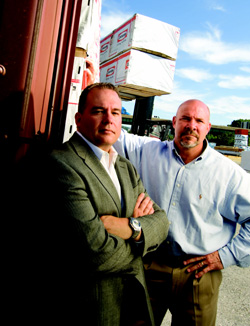What employees and executives learned during this three-year search of their quality conscience was that they were taking “too many non-value-added steps” for almost every activity, says Brown. “You can look at any process—receiving, purchasing. If there are 12 steps in there, in many cases, you can do that in six steps. That will improve the process by making it more accurate, more efficient. And that’s what we’re doing. It takes the cost out of what we do.”
A case in point was The Lumber Yard’s practice of ordering windows and doors from its supplier. In what Brown refers to as “the old days,” the supplier would create an invoice for the order and mail it to Wolf’s accounts payable department. An accounts payable clerk at Wolf would match the invoice against the purchase order to make sure the quantities and prices noted on the invoice agreed with the original order. Another clerk would enter the information into Wolf’s computer system, which would generate a check, and then print out the check. An authorized person would sign the check, and then someone would mail it to the supplier, who would open it and apply it against its outstanding invoices to Wolf.
Today, a Wolf employee creates a purchase order on the new computer system and transmits it to the window supplier, who does not send an invoice. If the computer finds no conflicts with pricing or delivery dates, it generates a wire transfer to the supplier’s bank account and sends an e-mail letting the company know Wolf has paid its bill.
Wolf uses that process—called evaluated receipts settlement (ERS)—with about 10 main suppliers of The Lumber Yard and with a handful of suppliers and customers of Wolf Distributing, whose clients for building materials are lumber dealers (including its sibling, The Lumber Yard), home centers, and kitchen and bath dealers.
“This is one of the most significant productivity gains we got out of this,” says Brown, who notes the firm once had 35 bookkeepers to process bills at its 18 lumberyards in 13 states from North Carolina to Maine. Now it has four.
Slowly, some of The Lumber Yard’s largest builder clients are asking for the same treatment. Instead of receiving an invoice with every delivery, they want a single invoice for each lot. “We’re in a position to do that for them,” says Brown.
Quality First By the time The Wolf Organization achieved its ISO certification for quality in 1997—a milestone it maintains by submitting to a quality audit of a sampling of its business processes every six months and to a full-blown certification audit every three years—it also was in a position to select the technology that would allow the company to put its pared-down processes into practice. It wasn’t the path executives, including Brown, expected to take.
“The original idea was to bring both of these initiatives along simultaneously,” recalls Brown, “but quality moved forward more quickly than [technology].”
That turned out to be a good thing for The Wolf Organization. “We got organized from a business standpoint first,” says Kostelich, “looking deeply at how products moved from end to end in our system. This would play right into the hand of implementing an ERP system.”
He notes: “At the end of the day, ERP—and particularly SAP—is a business event. It’s not really a technology event. It just automates the business processes for you.”

